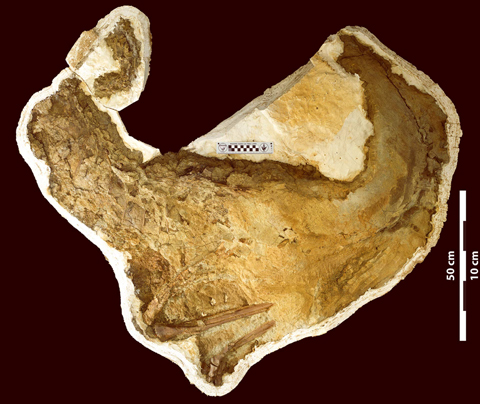In a Flap over an “Ostrich Mimics” Feathers
A Densely Feathered Ornithomimid from Dinosaur Provincial Park
Published in the scientific journal “Cretaceous Research”, why is everybody so excited about the discovery of yet another fossil of a theropod that shows feathers (at least integumental structures which include feathers)? Lots of media coverage on this fossil discovery, so why such a flap?
A Feathered Ornithomimus
The answer is fairly straight forward, the fossil (UALVP 52531), represents an Ornithomimus, a type of theropod dinosaur which had a small head perched on top of a long, slender neck, long legs and a very long tail. Think of Ornithomimus and its kin, the Ornithomimidae, as being very similar to a modern Ostrich (Struthio camelus), but with a tail of course. It is only the third Ornithomimus fossil to indicate that these Late Cretaceous dinosaurs had feathers and the first ornithomimid specimen to preserve a tail which shows extensive plumes, feathers which are longer than those present on the remainder of the body.
To read about the discovery of the first feathered ornithomimid dinosaur to be found in the Western Hemisphere, an article published by Everything Dinosaur in 2012: Canadian Researchers Find Evidence of Feathers in Ornithomimus.
The Fossil Material (UALVP 52531)
Picture credit: University of Alberta/”Cretaceous Research”
From the Dinosaur Provincial Park of Alberta
The specimen, pictured above had been collected during a 2009 expedition to the Dinosaur Provincial Park Formation of Alberta (Canada). It had been identified as an Ornithomimus, but as the head and forelimbs were missing it had largely been ignored. Aaron van der Reest, a palaeontology student at the University of Alberta was given the task of preparing the specimen, carefully removing the matrix to reveal more of the leg bones which can be seen in the lower portion of the photograph.
Within twenty minutes of working on the tail section, he came across some blackened impressions, these turned out to be feathers. What started out as an undergraduate project has catapulted Mr van der Reest into the world of published academia.
Two Years of Careful Preparation
After two years of careful preparation, this specimen has shed new light on the integumentary coverings of ornithomimids. It will help scientists to understand more about the different types of feathers and feathery structures that existed amongst the Dinosauria.
Commenting on the seventy-five million year old specimen (Campanian faunal stage of the Late Cretaceous), David Evans, curator of Vertebrate Palaeontology at the Royal Ontario Museum (Toronto) stated:
“It’s drop-dead gorgeous. It is the most complete feathered dinosaur specimen found in North America to date.”
The partial, articulated specimen is the first ornithomimid to preserve a tail with extensive feathers. These tail feathers are slightly longer than those present on the rest of the body. Intriguingly, the underside of the tail and the hind limb distal to the middle of the femur appear to have no feathers at all. This plumage pattern mapped out on the preserved Ornithomimus is very similar to that seen in an extant Ostrich (Struthio camelus).
The configuration of body feathers in Ostriches and other Palaeognaths (the Cassowary, Emu, Rhea and so forth), aids thermoregulation. The feather pattern seen in this Ornithomimus specimen probably served the same function, further evidence that this Theropod dinosaur was endothermic (warm-blooded).
An Illustration of a Feathered Ornithomimus
Picture credit: Julius Csotonyi
Feathered Ornithomimid
The fossil also shows the body outline around the legs, including skin patches in front of the femur, the authors of the scientific paper on this specimen suggest that the resting position of the femur was positioned more anteroventrally in ornithomimids than in most other Theropoda, and as a result may have been transitional to the situation in extant birds.
The research team conclude that whilst UALVP 52531 is not the first feathered ornithomimid dinosaur known from North America, the quality and extent of the feather and skin preservation is without equal. It is from this specimen that much more can be learned about the likely function of the integumentary covering in Ornithomimus and non-avian theropods in general.
So, that’s why there has been such a flap.
Everything Dinosaur stocks an extensive range of feathered dinosaur replicas and figures, to view this range: Everything Dinosaur Models and Figures.



